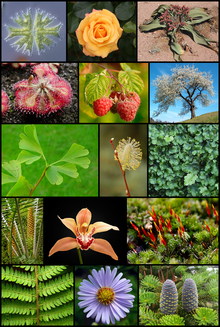Plant kingdom
| Plants Temporal range: Mesoproterozoic–present |
|
|---|---|
 |
|
| Scientific classification | |
| Domain: | Eukaryota |
| (unranked): | Archaeplastida |
| Kingdom: |
Plantae sensu Copeland, 1956 |
| Divisions | |
|
|
| Synonyms | |
|
|
Plants are mainly multicellular, predominantly photosynthetic eukaryotes of the kingdom Plantae.
The term is today generally limited to the green plants, which form an unranked clade Viridiplantae (Latin for "green plants"). This includes the flowering plants, conifers and other gymnosperms, ferns, clubmosses, hornworts, liverworts, mosses and the green algae, and excludes the red and brown algae. Historically, plants formed one of two kingdoms covering all living things that were not animals, and both algae and fungi were treated as plants; however all current definitions of "plant" exclude the fungi and some algae, as well as the prokaryotes (the archaea and bacteria).
Green plants have cell walls containing cellulose and obtain most of their energy from sunlight via photosynthesis by primary chloroplasts, derived from endosymbiosis with cyanobacteria. Their chloroplasts contain chlorophylls a and b, which gives them their green color. Some plants are parasitic and have lost the ability to produce normal amounts of chlorophyll or to photosynthesize. Plants are characterized by sexual reproduction and alternation of generations, although asexual reproduction is also common.
...
Wikipedia
